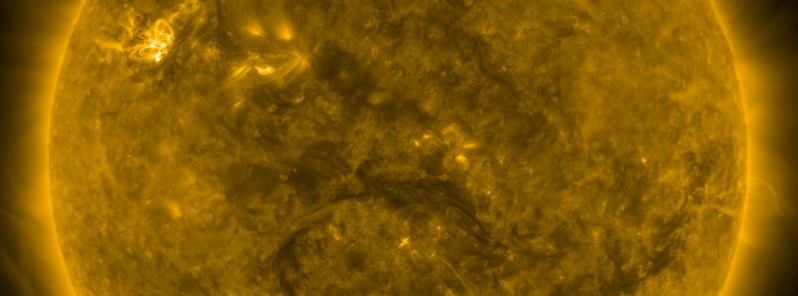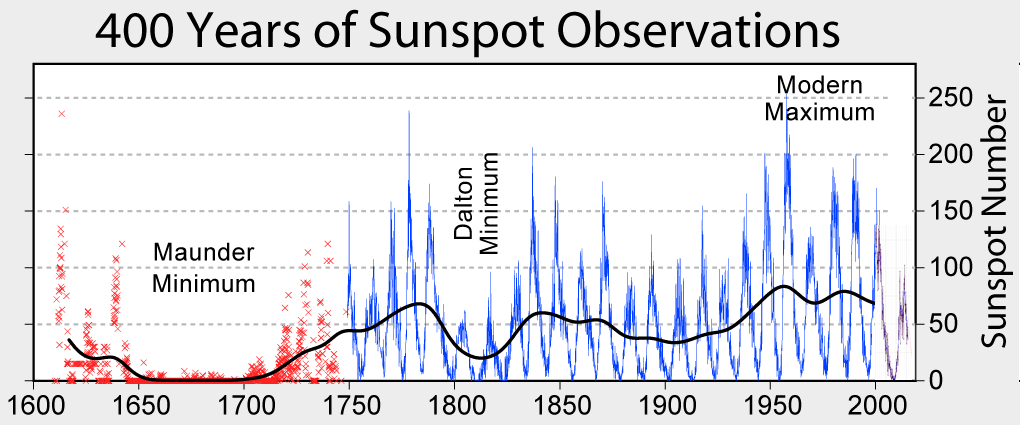Solar activity cycle falls to the bottom 1.5 years earlier than expected

According to the Laboratory for X-ray Solar Astronomy of the PN Lebedev Physical Institute in Russia, the solar activity cycle has, by all indications, practically reached its minimum 1.5 years ahead of expected time. Given that the previous solar maximum in 2012 was one of the weakest in the last century, it is possible, that we are now waiting for an earlier and substantially more "severe" minimum of the cycle.
There were no magnetic storms and field disturbances observed in the last two months related to solar activity, the laboratory said in a news release. Thus, space weather in the vicinity of our planet is increasingly losing its connection with the Sun, which by all indications practically fell to the bottom of the next minimum of the 11-year solar cycle 1.5 years earlier than expected.
At 5.7, the average monthly number of sunspots (one of the main indicators of the level of solar activity) reached a minimum value for the last 8 years of observations in November 2017. The last time the lower value was recorded in the last decade was in August 2009.
Although the decrease in the number of sunspots on the Sun is normal for our star, in this case, it occurs unexpectedly early, the laboratory wrote in an earlier release."Up to the minimum point of the solar cycle, there are still about 18 months, and usually at this stage, the sunspot activity of the Sun is higher."
The average number of sunspots in September was 43, it dropped to 13 in October and to 5 in November.
"It is possible that this indicates a faster approximation of the next solar minimum than was expected. Such cases, when intervals between solar minima were reduced from 11 to 10 and even 9 years, are known in the history of astronomy, but occurred quite a long time ago – about 200 years – called the Dalton minimum.

"Given that the previous solar maximum in 2012 was one of the weakest in the last century, it is possible, that we are now waiting for an earlier and substantially more "severe" minimum of the cycle.
"If so, it is impossible to exclude that solar activity is now falling to the bottom of a 100-year or even 1000-year cycle. Although the question of the presence of such global recessions in the Sun is still debatable, radiocarbon analysis of rocks and plants provides much evidence of the existence of such changes in the past."
Featured image credit: NASA/SDO (December 20, 2017)

The electric universe institute ,has the most credible theory about the sun and the other stars, they are powered by the cosmic electric energy that is flowing like giant rivers of electric current that illuminate the stars , Dave Talbot and Wal Thornhill produced the “Thunder bolts project ” it is a good information site about the work being done to inform the public of the truth about our universe.
So can we expect a mini ice age in the northern hemisphere?
This lowered sunspot activity no doubts must be caused by human activity, such as driving cars, raising cattle, or grilling over charcoal. We should probably start a search for a new sun.
That’s priceless!
It is abundantly clear to anyone who follows solar cycle activity that solar physicists have to make forecast revisions on an annual basis, resulting in a wobbly track record and plenty of processes designed to correct the corrections. Solar physicists predicted that 2013 would see an upsurge in solar activity and geomagnetic storms will disrupt power grids and communications systems. As we all know that came out to be false. Instead, the peak in the solar cycle in 2013 was the weakest for a century. Solar physicists can only make predictions based on the current data they have, and by comparing with historical patterns for the number of sunspots over time. After running models and simulations, they put their credibility on the line by announcing the most likely solar scenarios. I’m not surprised that physicists cannot predict solar activity and sunspot cycle. Current physics is totally wrong about the Sun’s magnetic structures and how it changes and what causes to change. There are external variables that influnence the sun’s magnetic field. The variation of the external energy supply that our star receives is the primary driver of its magnetic field and solar cycle activity. However, it is not only solar cycle activity that physicists cannot predict but all basic features and dynamical behavior of the sun in space are misunderstood. The physical reality of our star is different from the current dogma. When that physical reality will be understood, the real cause for climate change will be known and the ideal energy source will be produced. More important than the above, the integrity of astrophysics and cosmology will be restored to their right places.